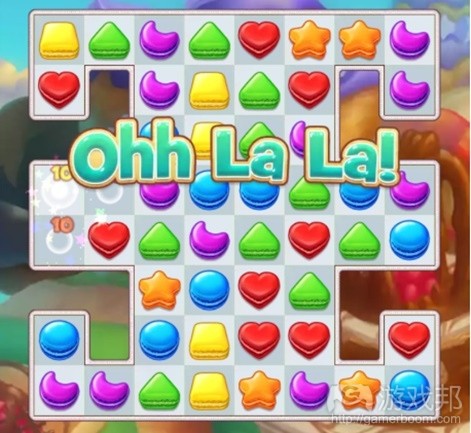GameRefinery:casual games休闲游戏的未来盈利趋势
GameRefinery:casual games休闲游戏的未来盈利趋势
原作者:Joel Julkunen 译者:Willow Wu
(本文作者是知名手游数据公司GameRefinery分析部门的负责人。)
对休闲游戏开发者来说,制定合适的盈利策略并不是一件容易的事。所以,今天我们就来分析几个大趋势,希望能帮助你获得新的灵感和感悟,在盈利方面有所提升。
首先我们要讨论的是,什么是休闲游戏?确定游戏类型并没有人们想象中那么简单。
更注重核心玩法
在这篇文章中,我们将根据GameRefinery的分类法来定义休闲游戏——这个分类法重点关注的是游戏特色和关键受众。
休闲游戏各式各样,但它们都有某些关键特征。不管是三消解谜、拼字游戏还是无尽跑酷游戏,都是:
·简单直接、易上手的
·流程短且令人享受
·聚焦于游戏的核心玩法(而不是Meta部分)
第三点就将我们引到了休闲游戏IAP盈利的话题上。休闲游戏以往的盈利策略都围绕着如何从核心玩法中榨取金钱。这就是休闲游戏和midcore游戏之间的主要区别。
它的盈利通常与三个要素有关:强化道具、继续游戏(以避免进度损失)以及限制能量/生命(取决于游戏类型)。它们的使用方法和目标都略有不同,但绝大多数休闲游戏都会出现。
然而,变化也在不知不觉中产生了。
Meta的崛起
在过去几年,手游市场已经走向成熟,特别是休闲玩家群体,他们已经将游戏套路摸得一清二楚。
他们想看到新的玩法,把时间投入在新鲜事物上。如果是五年前,像《糖果传奇》这种简单机制+重复性关卡+精致画面的游戏完全可以满足玩家,但现在你得提供更多东西才能维持原有的沉浸度。
这就是为什么近几年越来越多的休闲游戏出现了meta元素。我们看到很多休闲游戏都加入了收集机制,外加特别设计的角色、物品、建筑等等。
为什么有这么多游戏都使用了收集机制?答案很简单:它有效果。
对开发者来说,增加meta盈利元素的最大好处之一是它完全不会对核心玩法造成影响。
举个例子,你可以把任何一种收集机制加入到老虎机游戏中而且不会破坏核心玩法的平衡。
当你在着手准备新休闲游戏或者规划游戏发行后的特色更新计划时,收集元素是值得考虑的一个选项。
避免冲突
尽管meta盈利设计的使用率逐渐上升,但休闲游戏的盈利重点还是在核心体验上。
就如上文所说的,绝大多数休闲游戏的核心玩法盈利都从这三个地方入手:
·强化道具
·继续游戏
·限制能量/生命
它们都有自身的优势以及挑战。拿强化道具来说,它可以帮助玩家通过难关,免费赠送道具可以促使玩家对它形成依赖。
从另一方来说,有些玩家可能会觉得依赖这些道具通关就像是作弊,从而不愿意购买或者使用多个道具。其他人或许会囤起来,等到“真正难的关卡”才使用。但这样的关卡或许永远都不会出现,因为关卡只有更难没有最难。
诱使玩家继续游戏,它的优势&挑战跟强化道具有些相似,但是限制能量/生命就很不一样了,原因在于它经常会跟别的盈利机制产生冲突。
这个方法就是通过限制玩家实际的游戏时间、回合次数来盈利。也就是说,你试图通过核心玩法盈利,但同时又想通过限制游戏时间来挣钱,这就是一种矛盾。
让玩家尽情地玩!
上面说到平衡方面的挑战,我们就不得不提到最近在休闲游戏市场中观察到的另一个趋势。
越来越多热门产品的开发者都放弃把限制生命/能量作为主要盈利手段,为的是让其它方面的盈利设计发挥更好的效果(比如强化道具、继续游戏、收集机制)。玩家玩得越久,他们为进阶花钱的可能性就越高。
热门休闲游戏会定期轮换活动,并提供特殊的游戏模式,给玩家提供更有意义的、更多样化的内容。再加上宽松的游戏时长限制,开发者就能从核心玩法中获得更多收入。更妙的是,特殊的游戏模式、活动能够与meta盈利机制产生极好的协同作用(例如活动专属道具或角色)。
本文由游戏邦编译,转载请注明来源,或咨询微信zhengjintiao
Joel Julkunen is the head of game analysis at leading mobile game feature data provider GameRefinery.
Getting monetization right isn’t easy when it comes to casual games.
So we’re going to take a look at some macro trends to give you insights and inspiration to take your monetization to the next level.
First up we have to discuss – what are casual games?
Defining mobile game types and genres is not a simple task.
Casual gets more core
In this post, we’re going to define casual games according to our genre taxonomy, which focuses on the featureset and the key game audience.
Casual games come in all shapes and sizes so to speak, but they all share certain key characteristics. So whether it’s a match-3 puzzler, a word game or an endless runner, it’ll be…
-Straightforward and easy-to-learn
-Enjoyable in short sessions
-Primarily focused on core game (instead of the metagame)
The third point actually takes us to the subject of casual game IAP monetization.
As the core game is the key focus, the monetization of casual games has traditionally revolved around squeezing bucks out of core gameplay.
This is the primary difference between casual and midcore games.
The three main building blocks for monetizing your casual games core are Boosters, Continues and Energy/Lives (depending on the game type).
They all have slightly different uses and goals, but all three appear in the vast majority of casual games.
However, things are changing.
Meta on the rise
During the past few years, the mobile game market has matured and casual gamers, in particular, have become more familiar with gaming.
As a consequence, they are looking for new ways to be engaged. Five years ago it was enough to crush candies in repetitive levels with simple mechanics, but now you have to give your players much more to maintain that same level of engagement.
This is why meta game has been recently making its way to casual games. As a result, we’ve started to see a lot of collectible mechanics, plus character, item and building aspects in casual games.
The reason for this ‘collection boom’ is simple – it works.
One of the greatest things of adding meta monetization elements to your game is that it doesn’t have to affect the core game at all.
For instance, it’s possible to introduce almost any kind of collectible system to your slots game without breaking its core game balance.
This is something you might want to consider when working with your next casual game concept or creating a road map for feature updates post-launch.
Avoiding pitfalls
But even with this increase meta monetization, the primary focus of monetization for casual games remains the core experience.
As discussed earlier, you can pretty much find all core game monetization tricks from one of these three baskets.
-Boosters
-Continues
-Energy / Lives
Each of these elements has its own strengths and challenges. For example, boosters are great in allowing players to get through hard levels and freebies can be used to get players reliant on their powers.
On the other hand, some players might feel that relying on boosters is “cheating” and are reluctant to purchase or use them all together. Others might hoard boosters to use them in “really tough spots”, which then may never come, as there’s always a “tougher spot” on the horizon.
Continues have similar strengths and challenges as boosters, but monetizing through energy and lives is very different because it often clashes with other monetization mechanics.
This is because energy and lives are all about restricting players’ session length and the time they actually play the game. In other words, a conflict arises when you monetize by restricting play times but at the same time try to monetize gameplay.
Let the players play!
The balancing challenge laid out above is closely related to a recent big trend we’ve witnessed in the casual game market.
More and more top titles are loosening lives/energy monetization in order to boost the efficiency of their other sinks (e.g. boosters, continues, collectibles).
Players get to play more and as a consequence are more likely to spend money to progress (and save their progress).
It’s no surprise that top casual games regularly rotate various events and offer special playing modes so that players have more meaningful and diverse content to engage with.
Special playing modes and rotating events are an excellent way of giving players more meaningful core game content.
Together with “loose enough” session length restrictions, they help in creating more core game monetization sinks. And what’s even better, special playing modes and events have excellent synergies with meta layer monetization (e.g. event-exclusive collections or characters).
(source: pocket gamer )








































 闽公网安备35020302001549号
闽公网安备35020302001549号